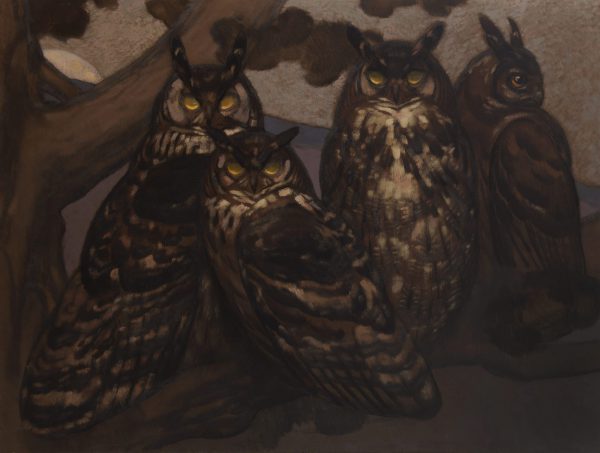Family of Eagle-Owls, ca. 1937.
Oil on card., H. 0.71 m; W. 1.02 m
Signed lower right: Jouve.
Provenance: Etude Gros & Delettrez, Voutier, Paris 2002.
Private collection, France.
Philippe Marcilhac, Paul Jouve. Vie et œuvre, Paris, 2005, p.181 (ill.).
Paul Jouve was from a very early age attracted to the art of drawing. His father Auguste Jouve, a painter and ceramic artist encouraged him, introducing him to the museums and the Jardin des Plantes where he developed a passion for large wild animals.
Preferring drawing from nature to the teaching provided at the Ecole des Arts Décoratifs and the Ecole des Beaux-Arts, he visited assiduously the Jardin des Plantes, the horse market and abattoirs that were very close to his father’s studio. At the same time, fascinated by the work of the Flemish engravers, he became interested in lithography and learned this technique in the studio of the lithographer Henry Patrice Dillon.
His vocation as an animal painter asserted itself quickly. At 16 years old, he exhibited his first work, the Lions of Menelik, at the Salon des Artistes Français. His participation in the décor of the Universal Exposition of 1900 marked the beginning of his fame.
Like the great animal painters of the 19th century, Paul Jouve regularly visited the great European zoos, especially those of Hamburg and Antwerp, to study the anatomy of his models. It was through this that he met Rembrandt Bugatti with whom he formed a friendship. On his return, in 1911, he took over Gérôme’s former painting studio in Notre Dame des Champs where he worked until his death.
He undertook several journeys, especially to the Far East in 1922, where he visited Indochina, China, Ceylan and India. He stayed at Angkor for almost three months, fascinated by the beauty and grandeur of the site. This trip undeniably had an influence on his work, as did his journeys to Africa from whence he brought back magnificent drawings.
A painter and engraver, Paul Jouve is also famous as an illustrator, as shown by his illustrations for R. Kipling’s Jungle Book, for P. Loti’s Un Pèlerin d’Angkor and Leconte de Lisle’s Des Poèmes Barbares. He also created sculptures that are very realistic, such as the Head of a Bull and Deer Leaping for the Esplanade of the Palais du Trocadero in Paris, made in 1937.
All his life, he was fascinated by animals. In his works he always distance them from any tense situation or brutality and depicts them for themselves, with great benevolence, as our painting shows.
